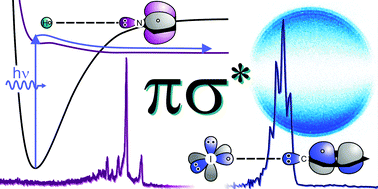The last few years have seen a surge in interest (both theoretical and experimental) in the photochemistry of heteroaromatic molecules (e.g. azoles, phenols), which has served to highlight the importance of dissociative excited states formed by electron promotion to σ* molecular orbitals. Such excited states—which, for brevity, are termed πσ* states in this Perspective article—may be populated by direct photo-excitation (though the transition cross-sections are intrinsically small), or indirectly, by non-adiabatic coupling from an optically ‘bright’ excited state (e.g. an excited state resulting from π* ← π excitation). The analogous πσ* excited states in prototypical hydride molecules like H2O and NH3 have long been recognised. They have served as test-beds for developing concepts like Rydbergisation, conical intersections (CIs) between potential energy surfaces, and for investigating the ways in which non-adiabatic couplings at such CIs influence the eventual photofragmentation dynamics. This Perspective article seeks to highlight the continuity of behaviour revealed by the earlier small molecule studies and by the more recent studies of heteroaromatic systems, and to illustrate the photochemical importance of πσ* excited states in many broad families of molecules. Furthermore, the dynamical influence of such excited states is not restricted to closed shell species; the Article concludes with a brief consideration of the consequences of populating σ* orbitals in free radical species, in molecular cations, and in dissociative electron attachment processes.

You have access to this article
 Please wait while we load your content...
Something went wrong. Try again?
Please wait while we load your content...
Something went wrong. Try again?


 Please wait while we load your content...
Please wait while we load your content...